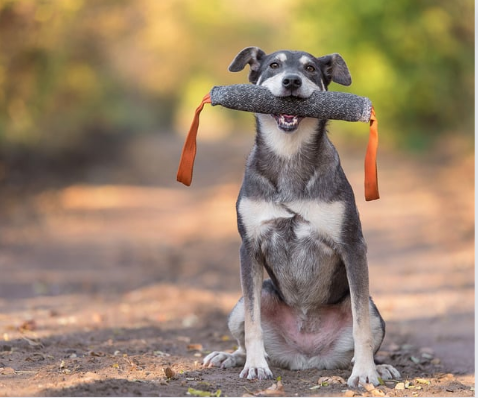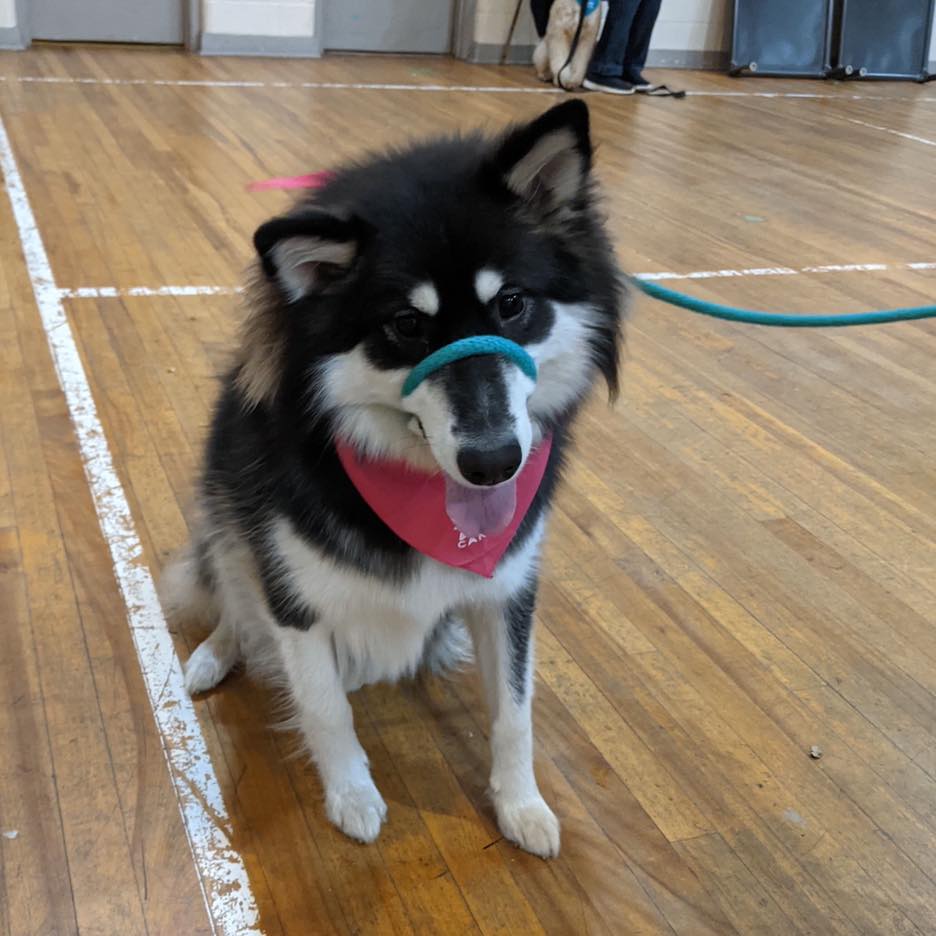by The Crunchy Canine | Jun 18, 2024 | BLOG
As dog owners, we often spend a lot of time training obedience commands, taking our dogs for walks around the block, and complaining about all the things our dogs do that annoy us or the things we wish our dogs knew how to do….but do we spend much time thinking about how we can be a better dog owner? One easy and simple thing we can do to be better dog owners is to play with our dogs.
Here are 6 great reasons you should be adding play to your daily routine with your dog!
1. Physical Exercise: Play helps keep dogs physically fit, preventing obesity and related health issues.
2. Mental Stimulation: Engaging in play challenges a dog’s mind, preventing boredom and reducing the risk of destructive behaviour.
3. Socialization: Play with other dogs and humans helps dogs learn social cues, build social skills, and develop good manners.
4. Stress Relief: Play can reduce stress and anxiety, providing an outlet for pent-up energy and emotions.
5. Bonding: Play strengthens the bond between dogs and their owners, fostering trust and companionship.
6. Behavioural Benefits: Regular play can improve a dog’s overall behaviour, and promoting a well-balanced temperament.
by The Crunchy Canine | Dec 17, 2023 | TESTIMONIALS
“I highly recommend Katherine and her team at The Crunchy Canine. Training is tactful and effective, for both humans and doggies. Big bonus if you can also tap into puppy socialization.
As a first-time dog owner, I gained confidence in how to handle all sorts of dog situations, and can take Benji with me to many places now. He walks beside me nicely, doesn’t snarl at other dogs across the street and has even grown to like the cat.
All through the guidance and education from The Crunchy Canine. Thank you.”
Karen with Benji in Hamilton, Ontario
by The Crunchy Canine | Dec 17, 2023 | TESTIMONIALS
“Amazing trainers! We completed the advanced off leash program with Katherine for our young GSD. The knowledge, guidance and support is second to none. Our boy now attends the awesome day camp every Wednesday as well. We have a dog we can go out with and enjoy living with because of the support we received and all we have learned. Highly recommend their services.”

Stephanie with Logan in Waterford, Ontario
by The Crunchy Canine | Nov 30, 2023 | BLOG
Did you know that every breed has a purpose? Every bred was bred for a specific job. Many people buy a dog based on looks, or because they met one or two dogs of a certain breed, and thought “wow I really like this breed, I think I should get one”. The problem is that without doing any research on the breed, you might be in for a big surprise when the dog is displaying the exact behaviours they were bred to do (the behaviours you may not like). We get MANY inquiries for dog training where owners are complaining about their dogs behaviour and when we see what breed the dog is, we know that this owner did not do their research. It is the owners responsibility to learn about the breed, and find out how they can meet the dogs needs and keep them happy and fulfilled. It is not the dogs responsibility to go against their genetics and conform to meet the human’s wants simply because the human did not do their homework.
So what is it that your dog was bred to do? Even if you already have a dog, and you did not research the breed, it is not too late. We see people learn, evolve, grow, and adapt all the time to the dog that they have! It comes down to what are you willing to do to be a better more educated dog owner.
Here is a list of the top 15 most common breeds and/or breed categories that we see in pet dog homes that often display behaviours that the owner was not prepared for and what they were bred for:
- German Shepherds – Bred for herding and guarding sheep. They are extremely athletic, and while they should be friendly they are bred to be inherently leery of people outside of their inner circle (which is why they make great guard or protection dogs).
- Retrievers (Golden Retrievers, Labrador Retrievers and Poodles) – Bred to retrieve water fowl for hunters. Love water, will fetch/retrieve indefinitely. Strong drive to work and put objects in their mouth.
- Hounds (Dachshunds, Beagles, Coon Hounds etc) – Bred to follow their nose. Tracking is their main purpose in life. Their nose will override almost anything else. Incredibly independent, bred to work and cover plenty of ground.
- Mastiffs (English, Bull, Cane Corso, Dogo D’Argentina etc) – Bred to guard and protect homes and property. Instinct to protect from other animals including dogs and large animals like bulls, bears and even lions.
- Rottweilers – Bred to protect and guard livestock and property. Naturally leery of outsiders.
- Dobermans – Bred for protection. A guardian breed, naturally suspicious.
- Terriers (Jack Russel, Parsons, Yorkshire, Wheaten etc) – Bred to hunt and kill rodents and small animals. Strong prey drive and willingness to not back down. Will shake and kill small animals. One of the more intense working breed categories.
- Boxers – Originally bred for hunting and guarding. High energy, protective in nature.
- Pointers (Weimaraners, German Short Haired Pointer, Vizla etc) – Bred to hunt large game and adapted to smaller animals. They excel in hunting pointing, and retrieving.
- Border Collies & Australian Shepherds – Bred to herd livestock. Intense drive to control and move other animals and people. Bred to use their mouth to control livestock as well by nipping at heels/ankles.
- Bernese Mountain Dogs – Bred to pull carts and to drive cattle, as well as protect livestock from predators.
- Doodles (all of the varieties) – Half retriever, half whatever they are bred with. You can get the best of both worlds or the worst of both worlds.
- Spaniels (Cocker, Springer and Brittany) – Bred to flush out game for hunters. Natural swimmers and will retrieve water fowl.
- Schnauzers – Bred to hunt vermin and protect livestock.
- Huskies & Malamutes – Bred to pull heavy sleds and cover ground. Malamutes were also bred to protect their families.

by The Crunchy Canine | Feb 14, 2022 | TESTIMONIALS
“

We originally came to the Crunchy Canine for help with Luna’s over excitement and extreme pulling when we walked her. At one point, her pulling and excitement got so bad, walking her became a chore that no one enjoyed or looked forward to.
We tried a multitude of tools (leash, slip-lead, gentle-leader etc. etc. etc…) but nothing seemed to register with Luna, or, she would get better for a bit and then get used to whatever tool we were using and it was back to square one. Once we started to advance her training and worked one on one with Katherine, we decided to switch her over to the remote collar. After the first week, we saw a significant change in Luna – for the better – she was responding more, being more aware of us and what we wanted from her. She was even noticeably starting to enjoy her walks more, as she never really enjoyed walking with the gentle leader on or any of the other tools we tried. But with her collar, she genuinely seemed so much happier. She had more freedom, less restraint but more control and consistency with her training. There was now a very clear, “black and white” approach to our training and more structure. Her recalls started to improve to the point where after the first few weeks, she was coming on command, staying by our side and with little to no motivation from the e-collar, she just started to understand what we expected from her more. We are improving each and every day and for the first time in a long time, we are extremely excited and hopeful that the remote collar is going to bring Luna to a point where she can have the best life possible. We are confident that our choice to switch to the remote collar was the right choice and one we will forever be thankful for.
A lot of people are apprehensive of the remote collar at first… but from our experience and after having used NUMEROUS tools, I can confidently say that the remote collar was the best decision we have ever made, besides the day we decided to get our Luna, of course ! If you’re thinking about making the switch, do it! This tool can seriously change yours and your dogs life, it did for us!”
Jordan with Luna from London, Ontario





